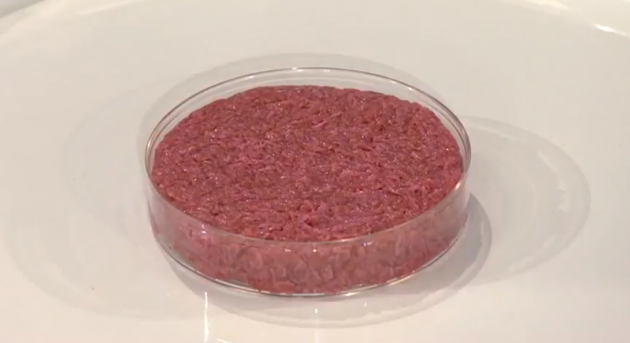Lab Grown Meat Can Solve Some Problems of Conventional Meat Industry
Food-print, or food’s carbon footprint, is the GHG emissions produced by growing, rearing, farming, processing, transporting, storing, cooking and disposing of food that we eat. Transport, food, and housing have the three largest carbon footprints. Food produces nearly 8 tons of emissions per household, or about 17%. Meat, cheese, and eggs have the highest footprint but fruits, vegetables, nuts, and beans have much lower. Moving towards a vegetarian diet has a large impact on our personal carbon footprint. It is to be noted that the carbon footprint of a vegan diet is about half that of a non-vegan diet.

Table showcasing greenhouse gas emissions produced by 1 kilo of each food is given below-
| Rank | Food | CO2 Kilos Equivalent | Car Miles Equivalent |
| 1 | Lamb | 39.2 | 91 |
| 2 | Beef | 27.0 | 63 |
| 3 | Cheese | 13.5 | 31 |
| 4 | Pork | 12.1 | 28 |
| 5 | Turkey | 10.9 | 25 |
| 6 | Chicken | 6.9 | 16 |
| 7 | Tuna | 6.1 | 14 |
| 8 | Eggs | 4.8 | 11 |
| 9 | Potatoes | 2.9 | 7 |
| 10 | Rice | 2.7 | 6 |
| 11 | Nuts | 2.3 | 5 |
| 12 | Beans/tofu | 2.0 | 4.5 |
| 13 | Vegetables | 2.0 | 4.5 |
| 14 | Milk | 1.9 | 4 |
| 15 | Fruit | 1.1 | 2.5 |
| 16 | Lentils | 0.9 | 2 |
Source: http://www.greeneatz.com/foods-carbon-footprint.html
History of Introduction of Lab Cultured Meat
In a 1932 essay, Winston Churchill foretold that within 50 years we would be growing edible animal parts to evade the hokum of growing a whole chicken. He was not wrong. A NASA funded project, in 2002, grew fillets from goldfish cells successfully, but it was a little later that lab-grown meat started a revolution of its own.
Starters to the Rescue – Professor Mark Post
It all started with a hamburger!
A hamburger which was grown entirely outside an animal’s body by a Professor of Vascular Physiology at Maastricht University in the Netherlands, Mark Post.
In a procedure similar to a biopsy, Prof. Post and his team utilized stem cells extracted from cow muscle tissue to grow the burger. The cells were then put in a solution of bovine serum taken from unborn calves. These then received food, hormones, and other elements naturally needed to grow. Over a period of few weeks, these cells multiplied and continued to form thin strips of muscle. It took about 20,000 of such strips to make 1 patty. The project cost nearly $330,000.
Taste testers approved of this product and proclaimed it was very meaty. Much of red meat’s taste actually comes from its fat content. This did not exist in the lab-grown burger, complicating the job of meat creators. It is difficult to create two types of tissues in the lab (Reference).
Companies to Feed New Generations Synthetically
According to livestock researchers: animal agriculture uses 30% of all land, 25% of all freshwater on the Earth, and creates as much greenhouse gas emissions as all of the world’s automobiles, both air and land combined. Hence, procedures and technologies are developing such that this excess is reduced to a contained value, acting as saviors of our planet.
Without the use of antibiotics, a large environmental footprint, excess contamination and animal slaughter which comes with conventional meat production, clean meat involves taking a sample of animal cells and replicating them outside of the animal.
Vivera, a Dutch company is starting operations with the 100% vegan steak being launched into the market. It has already put the plant-based steak into production. Vivera has been one of the founders of meat alternatives in Western Europe since its foundation in 1990. British chain Tesco (one of the largest supermarket chains operating in the European Union) is also planning to offer the 100% vegan steak from 21 May 2018.
Some of the Companies catering to this new-age technology are listed as under:
- Aleph Farms:
It is co-founded by the Strauss Group. This group is a global food company and together with the Israel Institute of Technology – Technion, Aleph Farms combines unique food experiences with innovative spirit to make something previously unheard of. Their clean meat is closer to free range meat because of a proprietary approach developed by Technion. It focuses on growing the edible part of the animal directly in 3D using 4 types of cells. This makes sure an end-product which resembles in texture, taste, and structure to farmed meat, is produced (Reference).
- Impossible Foods:
They use 0% cows!
Thus, the Impossible Burger uses only a little of our Earth’s natural resources. Compared to rearing cows, this burger uses 74% less water, 95% less land, and creates 87% less GHG emissions.
The burger is made from simple, all-natural ingredients. This includes wheat, potatoes and coconut oil. An ingredient called heme, which is a basic building block of life on Earth, including plants but uniquely abundant in meat makes for the special ingredient of this burger (Reference).
- Memphis Meats:
Memphis Meats co-founder and CEO is Uma Valeti.
Their lab-grown meat process goes something like this, according to Valeti:
- Finding ultra-high quality cows and pigs.
- Taking meat cells from a pork shoulder or other cut of meat.
- Finding the cells capable of self-renewal and cultivating them in a sterile environment.
- Harvesting the cells early for tender cuts of meat.
- For textured cuts, these are harvested later.
Memphis Meats has claimed it requires just 3 calories of energy input for one calorie of energy output. Since the lab-grown meat is grown in a pathogen-free space, there is also little risk of antibiotic contamination (Reference).
- Finless Foods:
Finless Foods is a food start-up working towards growing healthy, delectable seafood, without any environmental devastation or health hazards of traditional fishing and aquatic farming. To create fish and seafood products, they use cellular-agriculture technologies to grow marine-animal cells.
Finless Foods began by producing bluefin tuna. This fish has been recently threatened by predatory fishing practices. Thus, they plan on easing the stress of wild fishing on bluefin tuna by producing it in a safe, protected way (Reference).
- Beyond Meat:
This start-up is dedicated to creating, and refining, products packed with high levels of clean nutrients. They obtain safe, high-quality ingredients like non-GMO soy and pea protein and eliminate any use of harmful additives. Their products include Beyond Burger, Beyond Sausage, Beast Burger, Beyond Chicken Strips, Beyond Beef Crumble.
They also act as front-runners to address the global issue of depletion of natural resources and to reduce the amount of unnecessary waste. Also decreasing dependency on animal protein and improving the manner in which all animals are treated are goals of this company. (Reference).
How to Limit GHG concentrations from Meat Industry?
There are a lot of things meat growers can do to reduce the amount of GHGs like methane produced for every kg of beef.
- An animal that is slaughtered at 16 months compared to one at 30 months will have emitted less methane during its lifetime. Therefore, optimizing animal performance is key.
- To reduce Nitrogen losses into the atmosphere, farmers should adopt dribble bars or trailing shoes as a method of slurry application, compared to splash plates.
- Animal health, genetics, and nutrition play an important role when it comes to the performance of any animal. Media to help farmers understand this concept needs to be formulated.
- Farmers need to be informed about the benefits of proper care-taking.
- Intensive livestock rearing is a major cause of greenhouse gases. Therefore, non-intensive rearing of livestock could be a way forward e.g., raising animals on marginal land. It would allow meat-eating with less environmental harm.
- By 2050, more than 5 million premature deaths could be avoided globally. But only if health guidelines on meat consumption were strictly followed. Proper adherence of these rules could also lead to a reduction in global healthcare costs by $1bn by mid-century.
Adopting Veganism to Survive
A research, led by scientists at Oxford Martin School, found that shifting to a mostly vegetarian diet, or even cutting down meat consumption to within accepted health guidelines, would result in a large loss to GHGs. Widespread adoption of a vegetarian diet would bring down emissions by 63% and following health guidelines on meat consumption could reduce food-related global emissions by nearly a third by 2050.
“We do not expect everybody to become vegan. But the climate change impacts of the food system will require more than just technological changes. Adopting healthier and more environmentally sustainable diets can be a large stop in the right direction”
said Dr Marco Springmann, lead author of the study, entitled “Analysis And Valuation Of The Health And Climate Change Co-Benefits Of Dietary Change.” (Reference)
Author’s Bio:
Adeela Hameed is pursuing Masters in Environmental Sciences at Amity University, Noida.



